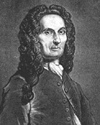
Abraham de Moivre
Probability and statistics may owe more to Abraham de Moivre than any person except Laplace. Greatly influenced by his friend Newton, de Moivre was the first to deduce a version of the Central Limit Theorem, showing that a large number of Bernoulli trials could be approximated by a normal distribution.
De Moivre published The Doctrine of Chance in 1718 -- with expanded editions in 1738 and posthumously in 1756. These texts not only solved problems such as the gambler's ruin chain that were suggested by others, notably Halley, Montmart, Huyguns, but also established fundamental tenets of probability such as the defnition of independent events.
De Moivre was born into a Protestant family in France. With the revocation of the Edict of Nantes in 1685, religious freedom in France was no longer permitted and De Moivre was imprisoned for his religious beliefs. Contemporary writings are unclear as to how long he was imprisoned: Protestant biographers indicate the term was for three years while Catholic biographers suggest he left for London in the year the Edict was revoked.
On arrival in England, de Moivre became familiar with Newton's work for the first time, eventually becoming a friend and confidant of Newton and other luminaries in the Royal Academy. Indeed, de Moivre was himself elected to the Royal Academy in 1697 and in 1710 was appointed to a commission to resolve the dispute as to whether Newton or Liebniz had invented the calculus. Clearly the Royal Academy, in appointing a friend of Newton's, knew what result it wanted!
While de Moivre enjoyed religious freedom in England and gained wide recognition as a mathematician, prejudice against foriegners was quite strong. Even with the help of friends like Newton and Halley, he was never able to obtain a position in England. Instead he survived primarily though income from private tutoring; Bournoulli wrote to Liebniz in 1710 that de Moivre lived a "miserable existence" due to the lack of an offical position. In the end, he died in poverty.
Born: 26 May 1667 in Vitry-le-François, Champagne, France
Died: 27 Nov 1754 in London, England
The premiere site for biographies of mathematicians on the web is at The University of Saint Andrews in Scotland; this is the primary source of the information in these short biographies. Some biographies used additional web resources as noted in the biography.
The postage stamp images came from a wonderful site on mathematicians on stamps maintained by Jeff Miller, a mathematics teacher in Florida.
The Free Internet Encyclopedia Wikipedia is also an excellent source of information and was used as a reference for many bographies.
The opinions expressed in these biographies are those of the author and do not reflect official views of the University of Oklahoma.
